Wall tiles for the kitchen: varieties and recommendations for use

In addition to choosing the right furniture for the kitchen, it is important to take care of the design of the wall surfaces, especially the apron. It is better to do this with tiles in order to provide both a stylish appearance and high functionality of the room.

Peculiarities
Kitchen wall tiles allow you to decorate the space in any color you like, as well as recreate unusual textures, such as wood, stone or leather. It does not deteriorate from kitchen products such as moisture, grease and steam. As the temperature rises, do not worry that the material will release harmful chemicals. Most often, the tile is located on the apron of the working area, that is, where it is important to additionally protect the wall from external influences - this is the wall located along the hob, sink and countertop. In this case, the height of the decoration reaches the wall cabinets.
If you wish, you can limit yourself to only some fragments, for example, only at the stove or sink. Some designs involve completely filling the kitchen walls with a pastel-colored coating. In this case, it will be very easy to keep the entire kitchen in order.
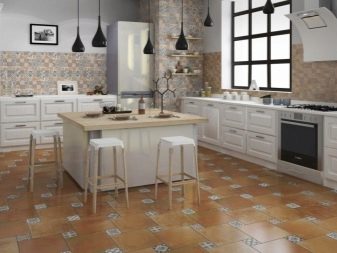

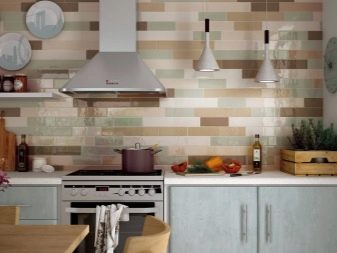
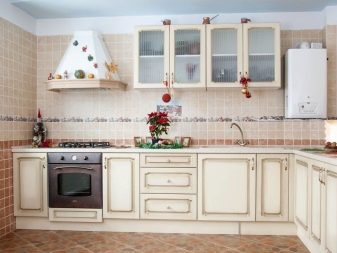
Views
The variety of wall plates on the market allows you to choose a design option for any wallet and for any design.
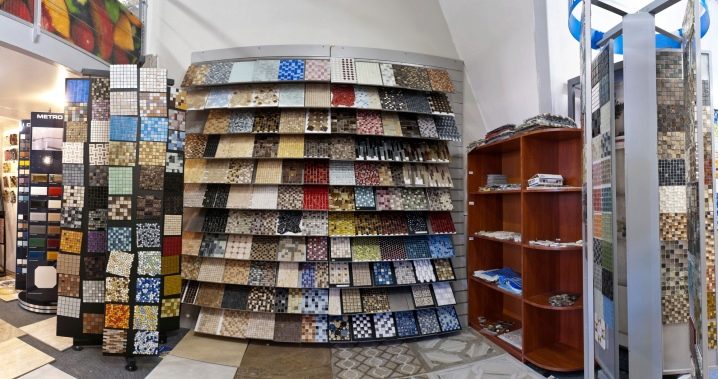
Materials (edit)
Ceramic wall tiles are considered the most common variety used for kitchen decoration. It is a durable material that is not afraid of mechanical stress, liquids, or high temperatures. In addition, ceramics does not deteriorate when exposed to fats or vapors, is easy to clean and does not deteriorate when treated with chemicals. Recently, PVC plates, bricks and even wallpaper have also begun to be used to decorate aprons.
PVC panels are easy to maintain, they are not afraid of high temperatures, but still have less strength than other materials. Its main advantage is the abundance of colors and textures, including wood or metal. PVC is used not only for covering the apron, but also for the decoration of facades.

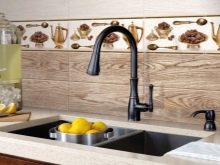

Forms
The most common tiles are available in the shape of a square, but there are also variations in the shape of a rectangle, suitable for the visual expansion of a small room. If we talk about small mosaic tiles, then they can be round, triangular, and hexagonal.

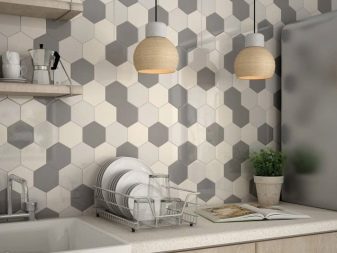
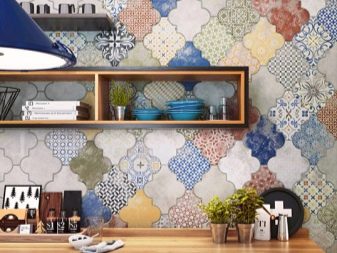
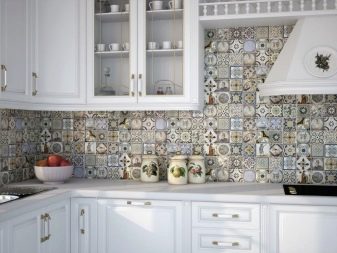
Design
Mosaic is considered one of the most popular tile designs. It looks like a pattern assembled from small details. Since the surface is resistant and not affected by detergents, the mosaic can be placed not only on the apron, but even on the floor. Often in interiors, mosaics are combined with plain tiles in the work area. Since this material beats quickly and is characterized by a lack of resistance, the work should be carried out with the utmost care, and the material should be purchased with a large margin.
Brick slabs fit well into an interior decorated in Provence or shabby chic style. Such a coating will also be relevant in a kitchen that resembles a loft. Brick tiles can vary in color, size and even texture.
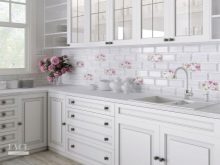

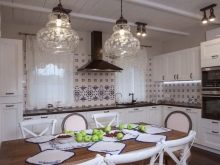
No less relevant is masonry under a tree, suitable for both walls and floors.Stone slabs look identical to natural materials, but are much cheaper. They perfectly fit the Mediterranean theme and are combined with oak furnishings. Currently, the actual coating imitating the skin imitating an animal print. Metal effect tiles are used in hi-tech or modern interiors.
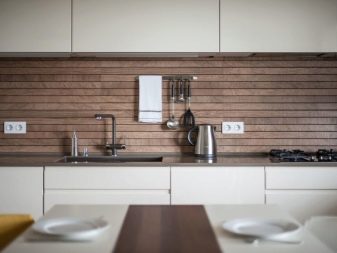
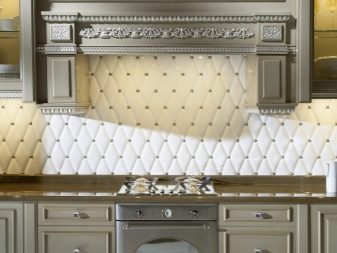
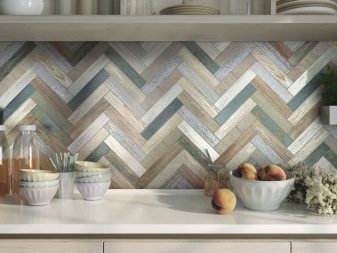
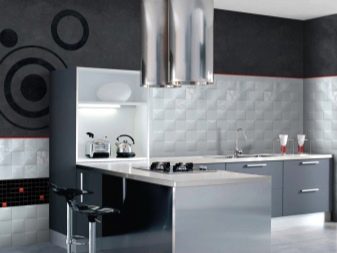
By the way, there is even a coating for gold or precious stones, but in a balanced interior they should be used only as accents. The same accent becomes the photographic image applied to a small area of the surface. Finally, the most unusual is called a glass sheet, inside which live or artificial plants are mounted.
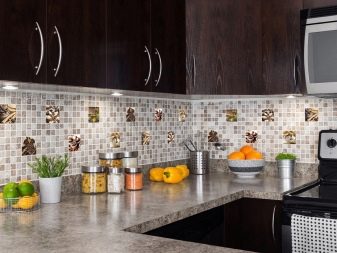
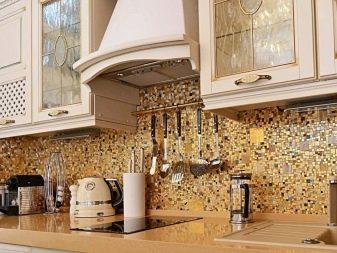
We must not forget that the tiles are matte and glossy. Gloss visually expands the space due to the appearance of glare due to the reflected light and creates an additional zest for the space.
It is recommended to use it in small kitchens with poor lighting, but it is important to understand that even minor damage will be noticeable. Matte tiles are considered cozier and more suitable for sunny spaces.
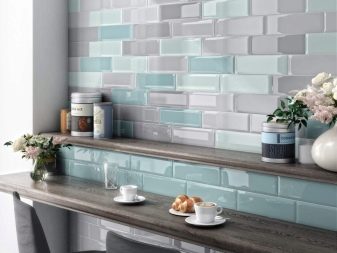
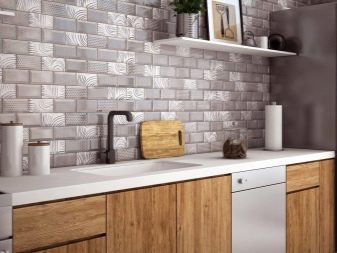
How to choose?
When purchasing material, you should do this with a margin of 10 to 15 percent. For the floor, it is better to take tiles with a rough texture, and for the apron, the headset is smooth. This greatly simplifies the process of caring for the material. The moisture resistance of the tile panel cannot be less than 0.03%. The size of the material largely determines how much you have to pay for it.
The dependence here is the opposite: for small tiles you will have to pay the largest amount, besides, you will have to work hard with the installation. Classic parameters are 10x10 cm. The weight of the tiles also affects the kitchen design process - lightweight elements are much easier to mount, especially on uneven surfaces.
When deciding whether to choose light or dark coatings, it should be understood that in the first case, dirt will be more noticeable, and in the second, damage. The color should be combined with the kitchen set, and with the ceiling and walls.
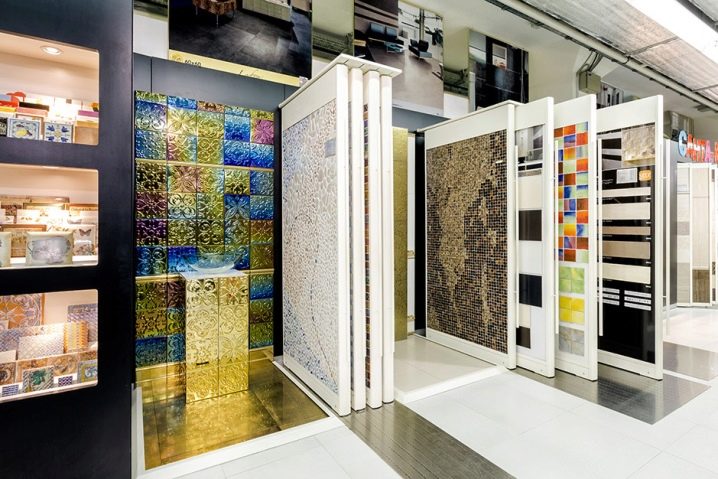
A small space requires the use of pastel colors that visually enlarge the room. Bulk ceramic coating will work in the same way. It is also recommended that the cover matches the worktop. If the tile is to be placed in the dining area, then it should be chosen as embossed as possible.
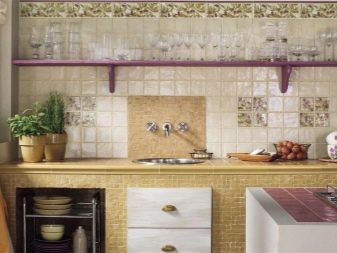
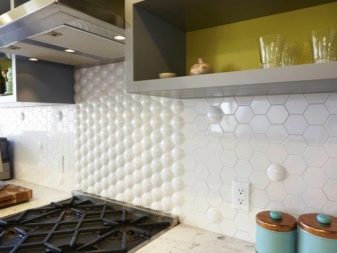
Laying and dismantling tips
To remove the old tile from the wall, you need to start with grouting - the process of removing the mortar with which the seams are processed. First, these gaps are soaked, then wiped off and finally cleaned with a spatula. In the case when it is necessary to remove only one cracked tile, a diagonal is drawn directly on it and holes of the minimum size are drilled, starting from the center. A chisel with a hammer will allow you to gently remove pieces without damaging solid slabs.
If the coating was installed on a brick or concrete base, then it will have to be removed with a hatchet with a wide blade or a combination of a hammer and a chisel. A narrow surface is driven under the slab, after which it is detached from the wall with a hammer blow. In the absence of a chisel in the household, it is allowed to replace it with a long screwdriver or chisel. Some craftsmen carry out this process with a spatula. First of all, the plate is tapped to determine the voids, after which the spatula is pushed in there. After hitting the hammer, the tiles can be removed.
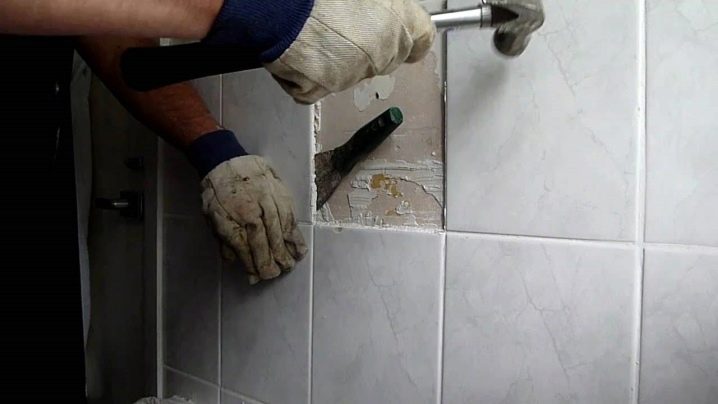
The use of a hammer drill almost immediately results in surface cleaning. The device starts working at a point between the plates. Steel hooks, which are driven under the surface, and then pulled to themselves, will also come in handy in this situation. The dismantling process is completed by cleaning the wall from the mortar using a spatula, scraper or trowel. The wall is moistened with a wet sponge, and then the residues are thoroughly removed.It is important to mention that the work should be carried out in a room covered with foil, where the floor is additionally protected by soft material.
Experts identify four ways on how to properly mount ceramic kitchen tiles. In the first case, the canvas should be laid as close to each other as possible parallel to the wall. Such a simple cladding is perfect for a voluminous monochromatic material. Square tiles can also be laid diagonally - in this case, it will be possible to level the surface to be treated and even externally increase the free space. Bricklaying should be glued with the same pitch as for real bricks.
If the canvas has a wood-like pattern, it must be laid out like parquet, creating a herringbone. Finally, in the case of modular masonry, the design takes place according to a special image.
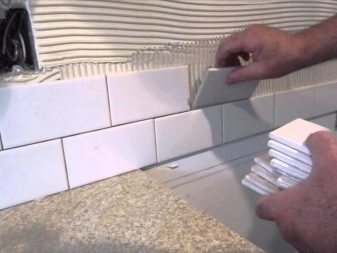
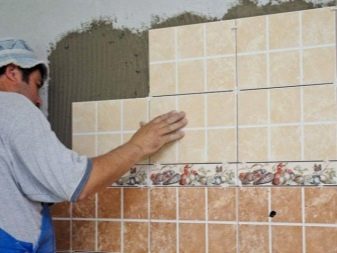
Care rules
Caring for kitchen tiles does not create any particular difficulties. After cooking, it should be thoroughly wiped clean, and approximately once a week cleaned thoroughly with suitable means. When processing the walls, it is worth using a foam rubber sponge or flannel, and the floor with a mop with a soft base.
Embossed volumetric tiles should be additionally cleaned with a small brush.
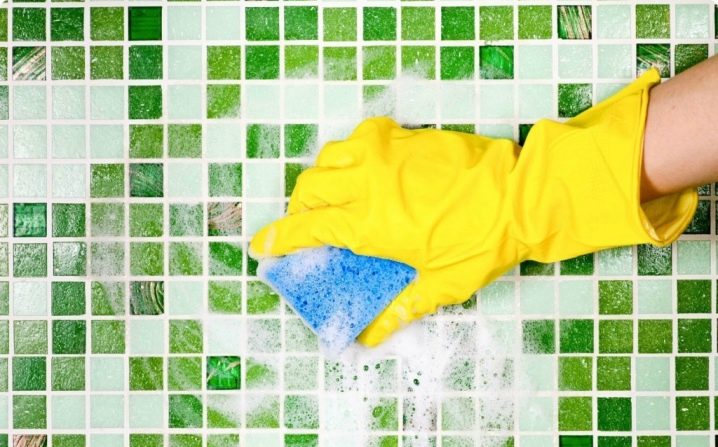
Examples in the interior
A very beautiful finish with ceramic tiles imitating white wood of different varieties. By choosing plates in the form of an elongated narrow rectangle of approximately five shades, it will be possible to stylishly decorate not only the apron, but all the walls, as well as the kitchen island. This design is perfect for a Scandinavian style with crisp white cabinets covered with wooden countertops. Laminate flooring should be selected in the same shades.
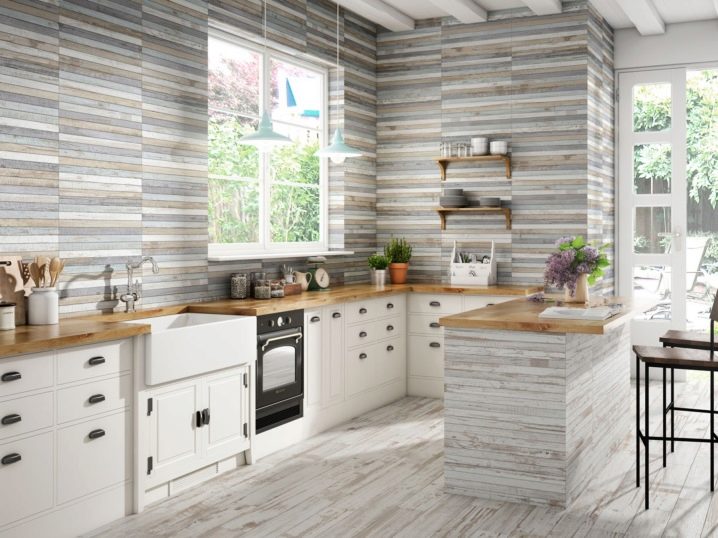
Sand-colored square tiles laid out on a diagonal are ideal for decorating a kitchen in a classic style. The cover can be embossed to create an unusual effect. Beige tiles require lockers in the same color scheme and ample lighting fixtures.
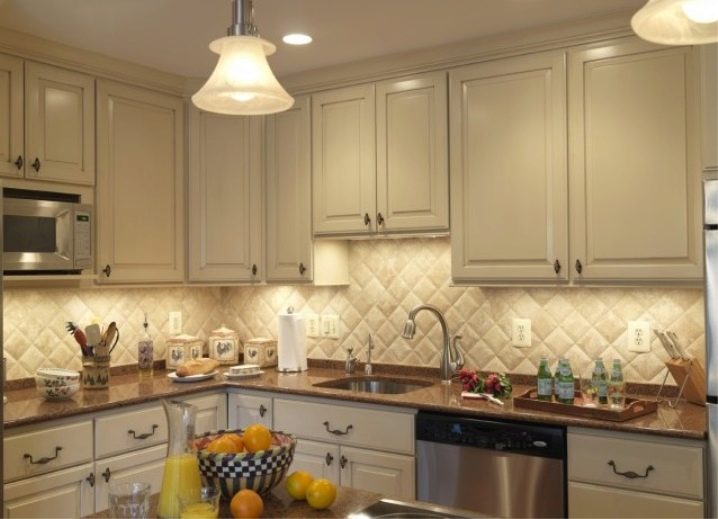
A brick tile covering in white is suitable for decorating a kitchen in a minimalist style. The walls will look much more impressive if the grout is dark.
The use of such a tile is appropriate only in terms of an apron near the work surface.
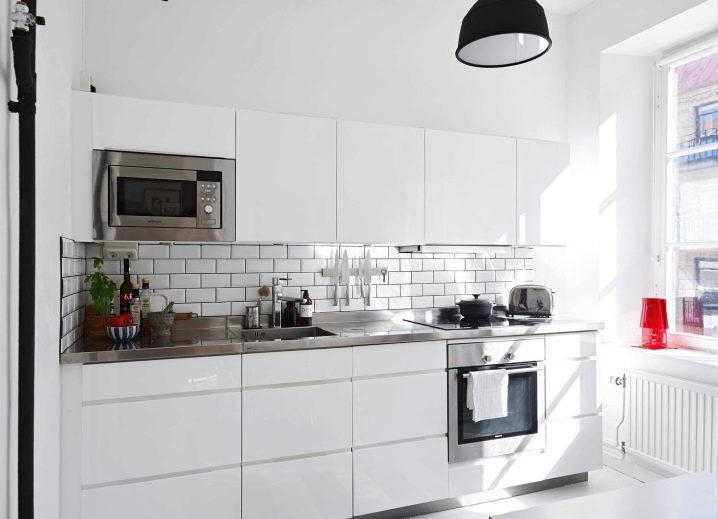
A combination of two types of tiles will look stylish and unusual. Closer to the table top, there will be several rows of coverings with a vertical texture reminiscent of a tree, painted in a snow-white shade. Fragments are better to take rectangular. Above, there will be one row of a dark blue shade with a horizontal texture under a tree. In the middle of each tile there will be a white rectangle with inscriptions.
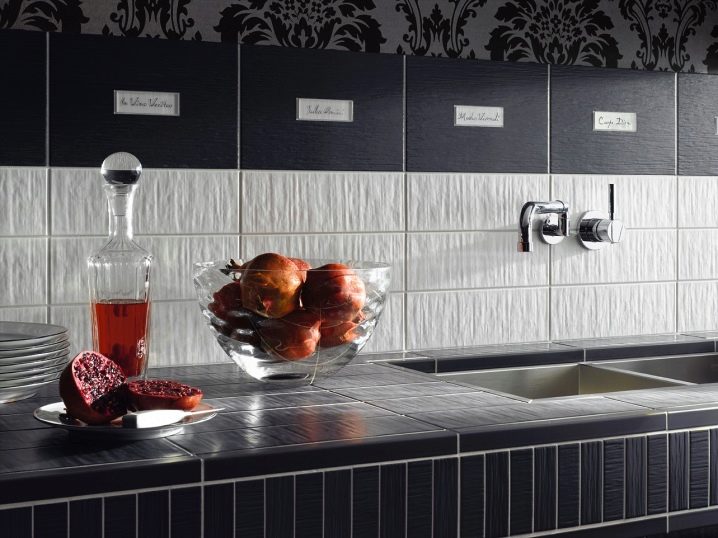
For information on how to choose tiles for the kitchen, see the next video.













The comment was sent successfully.